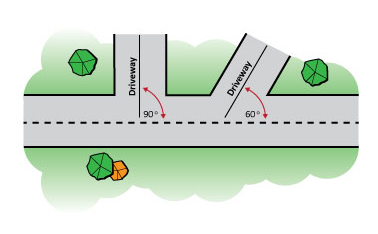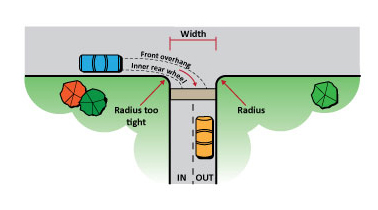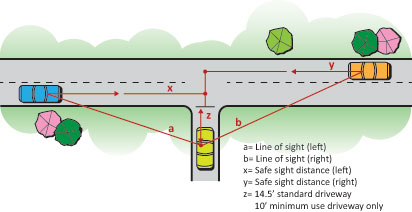Driveways
This design element pertains to multiple factors concerning driveways, including: classification, angle, grades, radii and width, setback from intersection, shared, sight distance, and spacing and number.
Classification
Driveway Classification
Every entrance or exit used by vehicular traffic to or from properties which are adjacent to rights-of-way and are expected to be used by more than a certain number of vehicles.
Standards
| High Volume | Medium Volume | Low Volume | Minimum Use | |
|---|---|---|---|---|
| Average Daily Traffic (ADT) | 1500+ | 1500 to 750 | 750 to 25 | Less than 25 |
See Pennsylvania Code, Title 67, Transportation, Chapter 441, Access To and Occupancy of Highways by Driveways and Local Roads.
Comments
High-volume driveways (1500+ ADT) often require signalization for large shopping centers, multi-family residential buildings and office complexes. Medium-volume driveways (1500-750 ADT)usually do not require signalization. Typical medium-volume driveways are used in motels, fast food restaurants, service stations and small shopping centers. Examples of low-volume driveways (750-25 ADT) are small office buildings, elementary or junior high schools and car washes. Minimum use driveways (less than 25 ADT) are associated with single family residential, multi-family residential with less than five units, and duplex housing.
Recommendation
Follow the recommendations of the Pennsylvania Code, Title 67, Transportation, Chapter 441, Access To and Occupancy of Highways by Driveways and Local Roads.
Angle
Driveway Angle
The horizontal angle at which a driveway joins the roadway, as measured from the centerline of the roadway to the centerline of the driveway.
Standards
PennDOT: Ninety degrees preferred, 60° minimum, unless otherwise specified as is the case with a filling station or when site conditions dictate otherwise. When two access driveways are on the same property and used for one way operation, each driveway may be between 45° and 90°; and 30° exit driveways may be used where no median opening exists.
Comments
The angle between the driveway centerline and the roadway edge should be based primarily on safety requirements. The speed at which a vehicle can enter or leave a public roadway is affected by the angle of approach or departure. Alternative designs are often used for relatively high entering and exiting speeds.
Recommendation
Follow the recommendations of the Pennsylvania Code, Title 67, Transportation, Chapter 441, Access To and Occupancy of Highways by Driveways and Local Roads.
Angle of Driveway

The angle of a driveway is measured from the centerline of the roadway to the centerline of the driveway.
Grades
Driveway Grades
The vertical slope of a driveway.
Standards
PennDOT: Please refer to the driveway design requirements, section 441.8, page 441-25 of the Pennsylvania Code, Title 67, Transportation, Chapter 441, Access To and Occupancy of Highways by Driveways and Local Roads.
Comments
Vehicles entering and leaving driveways which have abrupt changes in grade must travel at extremely low speeds. For those entering, the possibility of rear end collisions on the public street is greatly increased. The driveway profile is also important with respect to how it affects potential damage to the underside of vehicles. Driveways should be 1.5 inches above the grade of the pavement to maintain proper drainage and prevent ponding.
When residential driveway grades exceed ± 10% consideration should be given to a paved parking area outside the street right-of-way. This improves snow removal operations by removing vehicles from the street.
Recommendation
The grade of a driveway should be as close to 0.5 percent as possible. Where 0.5 percent grade is not feasible, follow PennDOT maximum grade values listed in the Pennsylvania Code, Title 67, Transportation, Chapter 441, Access To and Occupancy of Highways by Driveways and Local Roads.
Radii and Width
Driveway Radii
A measure of the sharpness of the corner formed by an intersecting driveway and road, independent of the angle at which the driveway intersects the road.
Driveway Width
The narrowest dimension of a driveway measured perpendicular to the centerline of the driveway.
Standards
High Volume Driveway
See PA Code, Title 67, Transportation, Chapter 441.
Medium Volume Driveway
| Single Unit Trucks and Passenger Vehicles |
Buses and Combination Trucks | |||||||
|---|---|---|---|---|---|---|---|---|
| Speed | Speed | |||||||
| < 45 MPH | > 45 MPH | < 45 MPH | > 45 MPH | |||||
| Min | Max | Min | Max | Min | Max | Min | Max | |
| Width | 14 | 28 | 14 | 28 | 14 | 28 | 12 | 28 |
| Radius | 15 | 30 | 15 | 50 | 45 | 55 | 50 | 55 |
Low Volume Driveway
| Single Unit Trucks and Passenger Vehicles |
Buses and Combination Trucks | |||||||
|---|---|---|---|---|---|---|---|---|
| Speed | Speed | |||||||
| < 45 MPH | > 45 MPH | < 45 MPH | > 45 MPH | |||||
| Min | Max | Min | Max | Min | Max | Min | Max | |
| Width* | 10 | 20 | 12 | 20 | 12 | 15 | 12 | 20 |
| Width** | 20 | 24 | 20 | 24 | 22 | 24 | 22 | 24 |
| Radius | 10 | 15 | 15 | 25 | 35 | 50 | 45 | 55 |
*One way driveway **Two way driveway
Minimum Volume Driveway
| Single Unit Trucks and Passenger Vehicles |
Buses and Combination Trucks | |||||||
|---|---|---|---|---|---|---|---|---|
| Speed | Speed | |||||||
| < 45 MPH | > 45 MPH | < 45 MPH | > 45 MPH | |||||
| Min | Max | Min | Max | Min | Max | Min | Max | |
| Width | 10 | 20 | 10 | 20 | 12 | 15 | 12 | 20 |
| Radius | 5 | 15 | 10 | 25 | 35 | 50 | 40 | 55 |
Comments
The preceding charts are recommended values. PennDOT may change the values based on site specific conditions, proposed uses, or a variety of reasons toowards sound engineering judgement. The radius should be related to the actual path of a vehicle making a right turn in or out considering the width of the adjacent street and the width of the driveway. The vehicle path should not encroach on the opposing lane during entering or exiting movements.
A larger turning radius will prevent vehicular conflicts. A radius of 75 feet could be considered on higher volume driveways where a deceleration lane cannot be constructed.
Recommendation
Follow the recommendations of the Pennsylvania Code, Title 67, Transportation, Chapter 441, Access To and Occupancy of Highways by Driveways and Local Roads.
Use a 5-foot radius on minimum use driveways within villages and on local access streets in subdivisions.
Poorly Designed Driveway

Setback from Intersection
Driveway Setback from Intersection (aka Driveway distance from intersection or corner distance)
The distance from the edge of the pavement of the intersecting roadway to the tangent of the radius of the first driveway.
Standards
PennDOT: General location restrictions. Access driveways shall be permitted at locations which:
- Sight distance is adequate to safely allow each permitted movement to be made into or out of the access driveway;
- The free movement of normal highway traffic is not impaired;
- The driveway will not create a hazard; and
- The driveway will not create an area of undue traffic congestion on the highway.
Driveways adjacent to intersections. Driveways serving properties located adjacent to a highway intersection shall be subject to the following:
- There shall be a minimum 10-foot tangent distance between the intersecting highway radius and the radius of the first permitted driveway.
- The distance from the edge of the pavement of the intersecting highway to the radius of the first permitted driveway shall be a minimum of 20 feet on curbed highways and 30 feet on uncurbed highways.
- Paragraphs (1) and (2) of this subsection may be waived only if the intersecting highway radius extends along the property frontage to the extent that compliance is physically impossible.
- Access to corner lots may be restricted to only that roadway which can more safely accommodate its traffic.
Comments
All driveways shall be located, designed, constructed, and maintained in such a manner as not to interfere or be inconsistent with the design, maintenance and drainage of the highway. (PennDOT)
A deep setback between an intersection and a driveway is desirable as a safety factor to avoid traffic conflicts at intersections.
Recommendations
- General location restrictions are found in the Pennsylvania Code, Title 67, Transportation, Chapter 441, Access To and Occupancy of Highways by Driveways and Local Roads.
- Follow the recommendations of the Institute of Transportation Engineers (ITE) for specific dimensions.
- Access to corner lots should be to the lesser order street and located at the property line most distant from the intersection.
See also DRIVEWAY SPACING AND NUMBER
Shared Driveway
Driveway Shared (aka Joint use driveway)
A driveway constructed to provide access to multiple properties.
Standards
AASHTO & PennDOT: 2-3 dwelling units per shared driveway
Comments
An economical and attractive method of serving a few homes while minimizing the number of driveways is through a shared or joint-use driveway. This is a privately owned and maintained, paved access which terminates at the last home. The width of the driveway should be wide enough for two cars to pass. PennDOT requires that a shared driveway be built to public road standards when it accesses a state highway and serves more than three dwelling units.
Recommendations
- Create shared or joint-use driveways to reduce the number of access points along a roadway.
- Follow the recommendations of the Pennsylvania Code, Title 67, Transportation, Chapter 441, Access To and Occupancy of Highways by Driveways and Local Roads, with some adjustments.
- A shared driveway serving only two dwelling units should be a minimum of 10 feet wide as long as a paved pullover area is provided. The location of the pullover area should be based on reasonable sight distance.
- Allow no more than three dwelling units to gain access to a private driveway.
- When more than three dwelling units access a single driveway, it should be built to public road standards.
- Resolve maintenance responsibilities through easements, deeds or letters of agreement.
Sight Distance
Driveway Sight Distance (aka Clear sight distance)
The minimum distance that a driver of a vehicle, situated at eye level, 3.5 feet high, and 10 feet back from the pavement edge, can continuously see along the road to another vehicle, at 3.5 feet high, approaching on the roadway.
Standards
FOR PASSENGER CARS AND SINGLE UNIT TRUCKS EXITING FROM A DRIVEWAY ONTO TWO-LANE ROADS
| Posted Speed | Safe Sight Distance: Left* | Safe Sight Distance: Right* |
|---|---|---|
| 25 MPH | 250 | 195 |
| 35 MPH | 440 | 350 |
| 45 MPH | 635 | 570 |
| 55 MPH | 845 | 875 |
FOR BUSES AND COMBINATION TRUCKS EXITING FROM A DRIVEWAY ONTO TWO-LANE ROADS
| Posted Speed | Safe Sight Distance: Left* | Safe Sight Distance: Right* |
|---|---|---|
| 25 MPH | 400 | 300 |
| 35 MPH | 675 | 625 |
| 45 MPH | 1225 | 1225 |
| 55 MPH | 2050 | 2050 |
FOR PASSENGER CARS AND SINGLE UNIT TRUCKS EXITING FROM A DRIVEWAY ONTO FOUR AND SIX-LANE ROADS
| Posted Speed | Safe Sight Distance: Left* | Safe Sight Distance: Right* |
|---|---|---|
| 25 MPH | 175 | 195 |
| 35 MPH | 300 | 350 |
| 45 MPH | 500 | 570 |
| 55 MPH | 785 | 875 |
FOR BUSES AND COMBINATION TRUCKS EXITING FROM A DRIVEWAY ONTO FOUR AND SIX-LANE ROADS
| Posted Speed | Safe Sight Distance: Left* | Safe Sight Distance: Right* |
|---|---|---|
| 25 MPH | 300 | 300 |
| 35 MPH | 625 | 625 |
| 45 MPH | 1225 | 1225 |
| 55 MPH | 2050 | 2050 |
FOR PASSENGER CARS AND SINGLE UNIT TRUCKS ENTERING DRIVEWAYS BY LEFT TURNS
| Safe Sight Distance*** | |||
|---|---|---|---|
| Posted Speed | Two-Lane | Four-Lane | Six-Lane |
| 25 MPH | 190 | 205 | 220 |
| 35 MPH | 300 | 320 | 345 |
| 45 MPH | 445 | 470 | 500 |
| 55 MPH | 610 | 645 | 680 |
FOR BUSES AND COMBINATION TRUCKS ENTERING DRIVEWAYS BY LEFT TURNS
| Safe Sight Distance*** | |||
|---|---|---|---|
| Posted Speed | Two-Lane | Four-Lane | Six-Lane |
| 25 MPH | 330 | 360 | 390 |
| 35 MPH | 485 | 530 | 575 |
| 45 MPH | 690 | 750 | 810 |
| 55 MPH | 905 | 990 | 1075 |
* Measured from a vehicle setback 10 feet from the pavement edge.
** Measured from a vehicle setback 10 feet from the pavement edge to a vehicle approaching in the outside lane.
*** Measured from a vehicle setback 10 feet from the pavement edge to a vehicle approaching in the median lane.
NOTE: The previous tables should be used only as a general guide. At the time of this document’s publication, PennDOT is in process of updating their Publication 282: Highway Occupancy Permit (HOP) Guidelines. DRAFT information for the Pub. 282 revision refers to Chapter 2 of Design Manual 2 (Pub 13M) and the AASHTO Green Book regarding sight distance values.
Comments
It is important to have adequate sight distance for all driveways to provide the best possible visibility thereby reducing points of conflict. Ordinances should allow municipalities to control vertical elements that obstruct essential sight distances. High-volume driveways at the crest of hills may require a left-turn lane to reduce accident potential and provide adequate sight distances.
Recommendations
- Follow the recommendations of the updated Publication 282: Highway Occupancy Permit (HOP) Guidelines regarding sight distance values.
- See also the PennDOT Driveway Sight Distance Measurements Form M-950S
Driveway Sight Distance

Spacing and Number of Driveways
Driveway Spacing and Number (aka Distance between driveways)
The amount and location of driveways in relation to other driveways. The distance is measured between curbline openings.
Standards
PennDOT: Number of driveways. The number and location of entrances which may be granted will be based on usage, interior and exterior traffic patterns, and the current design policies of PennDOT.
- Normally, only one driveway will be permitted for a residential property and not more than two driveways will be permitted for a non-residential property.
- If the property frontage exceeds 600 feet, the permit may authorize an additional driveway.
- Regardless of frontage, a development may be restricted to a single entrance/exit driveway, served by an internal collector road separated from the traveled way.
Multiple driveways serving the same property must be separated by a minimum distance of 15 feet measured along the right-of-way line and 20 feet measured along the shoulder, ditch line, or curb. When the distance between the multiple driveways is 50 feet or less measured along the shoulder or ditch line, the area between shall be clearly defined by permanent curbing. This curb shall be placed in line with the existing curb or two feet back of the shoulder or ditch line on uncurbed highways. It shall be extended around the driveway radii to the right-of-way line.
PennDOT does not provide specific standards for spacing between driveways on individual properties.
Comments
The greater the number of driveways that are intersecting the street, the greater the number of potential conflict points and accidents. Additional driveways also reduce street capacity and street speed.
Access management is particularly important on corridors served by transit bus routes. In the case of driveways adjacent to intersections, they should be placed, when possible, in such a way that does not unduly restrict the transit agency from placing a bus stop adjacent to the sidewalks and crosswalks that serve that intersection.
Many existing sites, particularly serving automobile-oriented uses, preclude bus stop placements because of uncontrolled or limited control access points or driveways placed in close proximity to the intersection. This may force the transit provider to create a mid-block stop, whereby the passengers either cross the arterial or collector in an uncontrolled location or they have to cross the aforementioned access points to reach a controlled crossing point.
Effective methods of eliminating excessive driveways are to integrate access points and eliminate unnecessary access points. These methods are especially useful when building on environmentally constrained lands.
Recommendations
- Recommendations for the number of driveways are found in the Pennsylvania Code, Title 67, Transportation, Chapter 441, Access To and Occupancy of Highways by Driveways and Local Roads.
- On arterial and collector roads align opposing driveways to avoid jogs or off-sets.
Shared Access



